Summer crop decisions and root lesion nematodes
Author: Kirsty Owen, Tim Clewett, John Thompson Agri-Science Queensland, Department of Agriculture, Fisheries and Forestry | Date: 16 Jul 2013
Kirsty Owen, Tim Clewett, John Thompson
Agri-Science Queensland, Department of Agriculture, Fisheries and Forestry
Take home messages
Getting soil tested is the only way to find out which species of root-lesion nematode are present in your paddock.
Crops and varieties within crops can differ in their susceptibility or resistance to root-lesion nematodes. For example, sorghum is resistant to Pratylenchus thornei but susceptible to P. neglectus. Mungbean is susceptible to P. thornei but resistant to P. neglectus.
Summer crops that are resistant to root-lesion nematodes can be used to reduce nematode populations.
More than one resistant crop may be needed to reduce high populations.
Introduction
Root-lesion nematodes (Pratylenchus thornei and P. neglectus) have a broad host range, and cause up to 60% yield loss in wheat and 20% yield loss in chickpea. Summer crops have an important role in management of root-lesion nematodes because some crops are susceptible and others are resistant. However, from our results, summer crops appear to be tolerant to root-lesion nematodes and there are no reliable symptoms of infection to tell you if the summer crop is resistant or susceptible. P. thornei and P. neglectus can infect different crops so the most important first step is: to get soil tested to know what nematode species are present.
|
A tolerant crop yields well when high populations of root-lesion nematodes are present (opposite is intolerance) A resistant crop does not allow root-lesion nematodes to reproduce and increase in number (opposite is susceptibility) ® There are 4 possible combinations of resistance and tolerance: |
|
|
Tolerant: Resistant e.g.: sorghum cv. MR43 and P. thornei And wheat breeding lines released for development |
Tolerant: Susceptible e.g.: wheat cv. EGA Gregory and P. thornei |
|
Intolerant: Resistant No commercial wheat lines in this category
|
Intolerant: Susceptible e.g.: wheat cv. Strzelecki and P. thornei |
Pratylenchus thornei
Pratylenchus thornei was found in 67% of paddocks in the northern region in a survey of 800 paddocks (Thompson et al. 2010). Summer crops that are partially resistant or poor hosts of P. thornei include sorghum, sunflower, maize, millet, panicum and pigeon pea. When these crops are grown, populations of P. thornei will not increase because the crops do not allow the nematodes to reproduce.
Summer crops that are susceptible or good hosts of P. thornei include mungbean, soybean, navy bean and cowpea. When these crops are grown, populations of P. thornei will increase, often to very high levels; the nematodes will survive fallow periods to infect future crops.
In an experiment in 2011 at Formartin, several varieties of summer crops were grown and P. thornei populations were assessed before planting and after harvest. P. thornei was found to 90 cm soil depth (Figure 1). Low populations remained after sorghum, sunflower and maize and were similar in the clean fallow treatment (Figure 1). Within these crops, varieties had a similar response to P. thornei and none were significantly different from the fallow treatment (Figure 2).
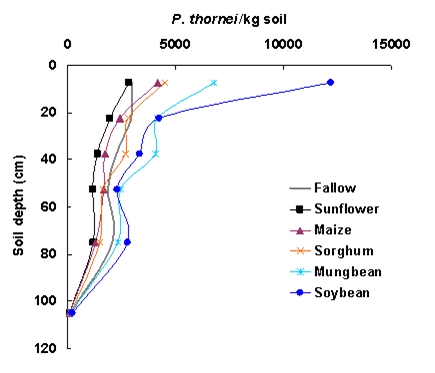
Figure 1. Populations of Pratylenchus thornei increased after growing mungbean and soybean. After growing sunflower, maize and sorghum populations were similar to land left in bare fallow. Means of several varieties within each crop are presented.
In contrast, populations of P. thornei increased after growing mungbean or soybean compared to sunflower, sorghum, maize or land left in fallow (Figure 1). There were differences between varieties of soybean and mungbean (Figure 2). Soybean cv. Soya791 was moderately resistant (4,800 P. thornei/kg soil at 0–15 cm) and did not differ significantly from the fallow treatment. However, all other soybean varieties were very susceptible. Populations of P. thornei increased 4–6.7 times and ranged from 12,000–20,600 P. thornei/kg soil at 0–15 cm. For mungbean, cv. Emerald
was moderately resistant (4,800 P. thornei/kg soil at 0–15 cm) and did not differ significantly from the fallow treatment. However, all other soybean varieties were very susceptible. Populations of P. thornei increased 4–6.7 times and ranged from 12,000–20,600 P. thornei/kg soil at 0–15 cm. For mungbean, cv. Emerald was moderately resistant (3,400 P. thornei/kg soil) and did not differ significantly from the fallow treatment. However, all other mungbean varieties tested were susceptible and P. thornei populations increased 2.2–3.8 times. Populations ranged 6,700–11,700 P. thornei/kg soil at 0–15 cm.
was moderately resistant (3,400 P. thornei/kg soil) and did not differ significantly from the fallow treatment. However, all other mungbean varieties tested were susceptible and P. thornei populations increased 2.2–3.8 times. Populations ranged 6,700–11,700 P. thornei/kg soil at 0–15 cm.
Summer crops that are susceptible or good hosts of P. neglectus include grain sorghum, forage sorghum and blackgram. When these crops are grown, populations of P. neglectus will increase often to very high populations.
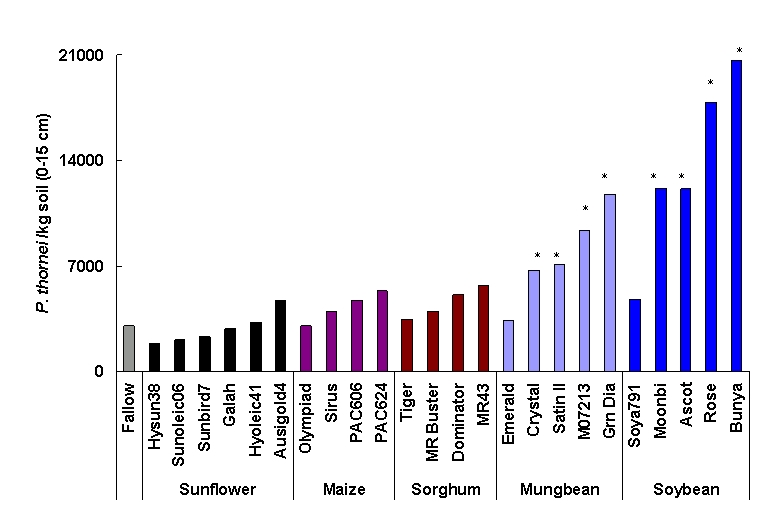
 All varieties listed are protected under the Plant Breeders Rights Act 1994.
All varieties listed are protected under the Plant Breeders Rights Act 1994.What is the economic impact of susceptible crops in a rotation?
In a previous P. thornei crop rotation experiment we grew a resistant or susceptible winter crop in Year 1, followed by summer crops in Year 2 and then after a long fallow, an intolerant wheat variety in Year 4. Yield of the Year 4 wheat was greatest (3.2 t/ha) when the two previous crops were both resistant to P. thornei, for example canaryseed followed by panicum. The poorest yield of the Year 4 wheat (1.4 t/ha) followed two susceptible crops, for example, wheat followed by mungbean. There was a strong, negative relationship between the yield of the Year 4 wheat and populations of P. thornei after harvest of the Year 2 summer crops (P<0.001, R2 =0.82). Yield loss of up to 68% was predicted by this relationship.
The impact of growing a P. thornei-susceptible crop in Year 1, such as wheat, was evident in Year 4, even when the summer crop in Year 2 was resistant (Figure 3). One resistant Year 2 summer crop, such as sorghum could not reduce all of the yield loss potential posed by P. thornei. For example the Year 4 wheat lost 33% of its yield if sorghum followed a susceptible winter crop compared to sorghum following a resistant winter crop. The message to take away is that when P. thornei is present in high populations two or more resistant crops in sequence are needed to reduce populations to low enough levels to avoid yield loss in intolerant: susceptible wheat crops that follow.
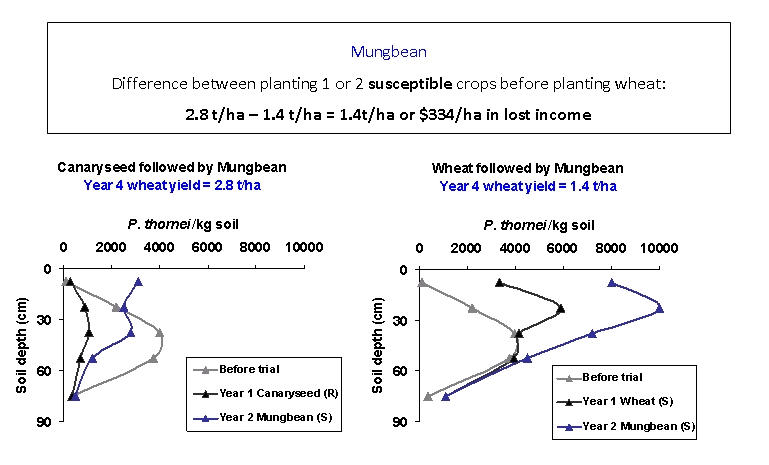
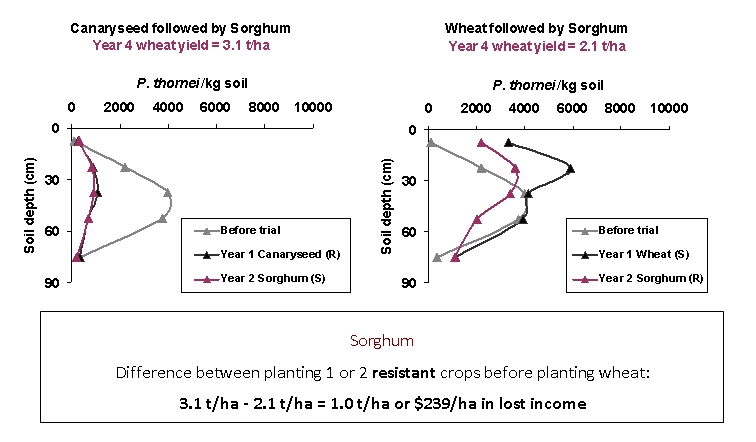
Figure 3. When Pratylenchus thornei is present in high populations more than one resistant crop in sequence may be needed to reduce populations. The grey line indicates P. thornei populations before the experiment began. In Year 1, wheat (susceptible) or canaryseed (resistant) was planted, followed in Year 2 by a mungbean (susceptible) or sorghum (resistant). In Year 4 the P. thornei-intolerant wheat cv. Strzelecki was planted. Cost of lost wheat yield is calculated at $239/ha based on a 10-year average.
was planted. Cost of lost wheat yield is calculated at $239/ha based on a 10-year average.
Pratylenchus neglectus
Pratylenchus neglectus was found in 32% of paddocks (often in combination with P. thornei) in the northern region in a survey of 800 paddocks (Thompson et al. 2010). Summer crops that are partially resistant or poor hosts of P. neglectus include sunflower, mungbean, soybean and cowpea. When these crops are grown, populations of P. neglectus do not increase because the crops do not allow the nematode to reproduce.
In a field experiment, populations of P. neglectus increased after growing grain sorghum (Figure 4). Populations increased from 3.1 times after MR32 (4,400 P. neglectus/kg soil) to 7.3 times after MRGoldrush
(4,400 P. neglectus/kg soil) to 7.3 times after MRGoldrush (10,400 P. neglectus/kg soil) compared to soil at planting (1,400 P. neglectus/kg soil).
(10,400 P. neglectus/kg soil) compared to soil at planting (1,400 P. neglectus/kg soil).
Forage sorghum is also susceptible to P. neglectus (Figure 5). The sweet sorghum hybrids (Hunnigreen and Nectar
and Nectar ) were very susceptible (populations increased more than 5 times) and the sorghum x sudan grass hybrids (Bettergraze
) were very susceptible (populations increased more than 5 times) and the sorghum x sudan grass hybrids (Bettergraze and BMR
and BMR ) were least susceptible (populations increased 1.8 and 2 times).
) were least susceptible (populations increased 1.8 and 2 times).
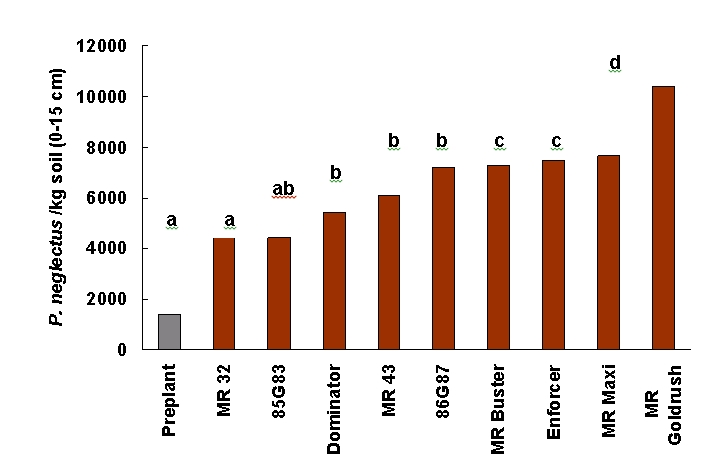
Figure 4. Grain sorghum is susceptible to Pratylenchus neglectus. After harvest of the grain sorghum, P. neglectus was found in highest populations at 0–15 cm soil depth. Populations increased 3.1 to 7.3 times (compared to the pre-plant soil samples indicated by the grey bar). Bars followed by the same letter are not significantly different at P<0.05; pre-plant soil was not included in the analysis. ‘ All varieties listed are protected under the Plant Breeders Rights Act 1994.’
All varieties listed are protected under the Plant Breeders Rights Act 1994.’
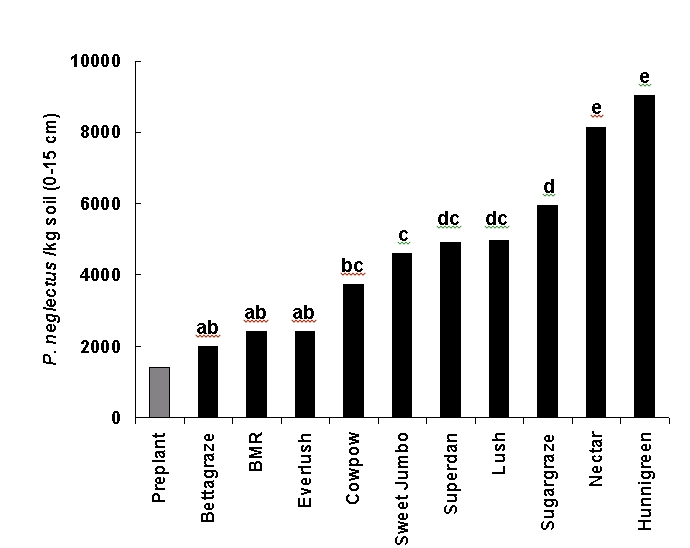
Figure 5. Forage sorghum is susceptible to Pratylenchus neglectus. After harvest of the forage sorghum, P. neglectus was found in highest populations at 0–15 cm soil depth. Populations increased 1.8 to 6.5 times (compared to the pre-plant soil samples indicated by the grey bar). Bars followed by the same letter are not significantly different at P<0.05 pre-plant sample was not included in the analysis. ‘ All varieties listed are protected under the Plant Breeders Rights Act 1994.’
All varieties listed are protected under the Plant Breeders Rights Act 1994.’
Conclusion
Root-lesion nematodes are found throughout the northern grain region. Have soil tested in a laboratory to determine the population densities of root-lesion nematodes and to find out which species are present in your each of your paddocks. If root-lesion nematodes are detected, there are two strategies to put in place: 1) for long-term management, include resistant crops in your rotations to keep populations of root-lesion nematodes at low levels, for example, sorghum when P. thornei is present. More than one resistant crop may be needed in sequence to reduce high populations of root-lesion nematodes. 2) Grow a wheat variety with tolerance to the species of nematode identified to ensure that yields are maximised (go to: nvtonline.com.au). .
Contact details
Kirsty Owen
Department of Agriculture, Fisheries and Forestry Queensland, Leslie Research Centre, PO Box 2282, Toowoomba, 4350
Phone: 07 46398805
Fax: 07 46388800
Email: Kirsty.Owen@daff.qld.gov.au
References
Thompson JP, Clewett TG, Sheedy JG, Reen RA, O’Reilly MM (2010) Occurrence of root-lesion nematodes (Pratylenchus thornei and P. neglectus) and stunt nematode (Merlinius brevidens) in the northern grain region of Australia Australasian Plant Pathology 39, 254-264.
Reviewed by
Stephen Neate, Jason Sheedy and Richard Daniel
 Varieties displaying this symbol beside them are protected under the Plant Breeders Rights Act 1994.
Varieties displaying this symbol beside them are protected under the Plant Breeders Rights Act 1994.
GRDC Project Code: DAQ00154,
Was this page helpful?
YOUR FEEDBACK
